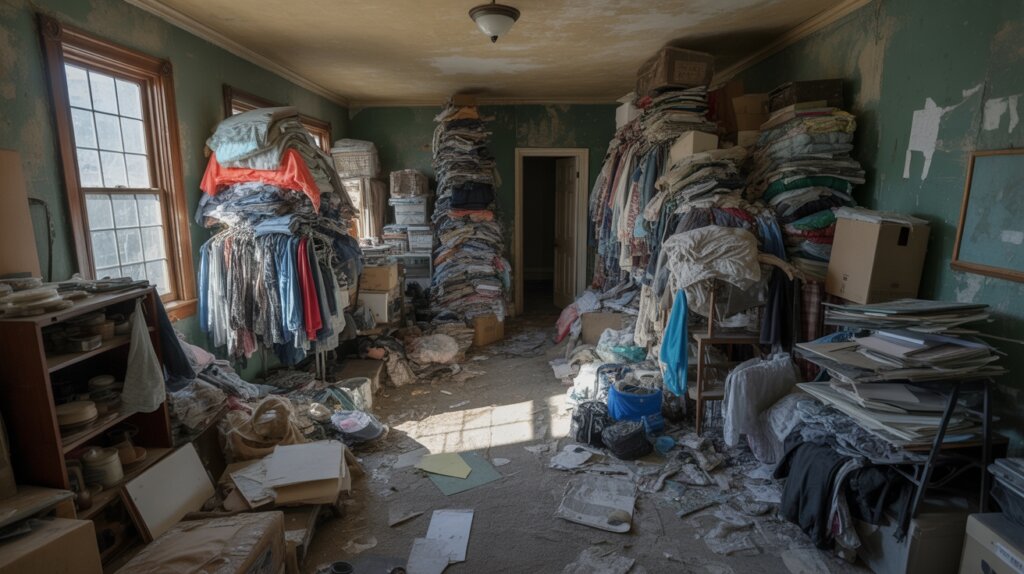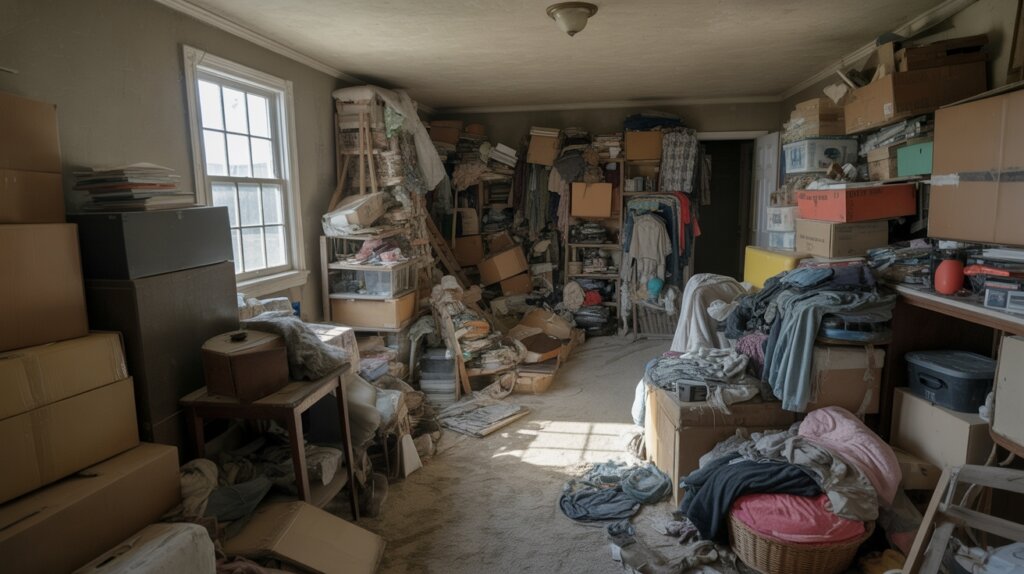Selling a hoarder house can feel overwhelming. The clutter, damage, and odors often scare away buyers or lower offers. You might wonder if renovating before selling is worth the effort or cost.
Ignoring these issues can make your house sit on the market for months. Buyers see hoarder homes as risky investments. They may expect steep discounts or refuse to even look inside.
You should renovate a hoarder house before selling if repairs are minor and the local market supports higher prices for move-in-ready homes.
Sometimes, simple clean-up and repairs can increase your profit and attract more buyers. This blog will guide you through the decision and help you choose the best path for your situation.
Key Takeaways
- Renovating a hoarder house can increase its market value and attract more buyers, but costs must not exceed potential profits.
- Simple cleaning, decluttering, and minor repairs often provide the best return without extensive investment.
- Professional inspections help identify hidden hazards and necessary repairs to ensure safety and legal compliance.
- In strong markets, selling as-is may be viable if buyer demand is high and renovation costs are prohibitive.
- Full disclosure of past hoarding and completed repairs is legally required to protect sellers and facilitate a smoother sale.
Understanding What Qualifies as a Hoarder House

A hoarder house is not just cluttered; it is filled with items to the point that normal living is hard. Rooms may be blocked off, and basic activities like cooking or sleeping can become impossible. If you see these signs, you may be looking at a hoarder house.
Hoarding is more than being messy. People with hoarding disorder have great trouble getting rid of things, even items without value. This behavior affects about 2% to 6% of adults. The urge to keep things is often linked to emotional distress and worry.
If someone feels anxious about throwing things away, hoarding may develop. Understanding this can help you notice the difference between simple mess and real hoarding. Hoarding goes beyond messiness—those affected struggle to let go of even worthless items, impacting millions of adults.
If you learn the signs of hoarding, you can judge a home’s condition better. Proper knowledge helps you plan what to do next. Recognizing hoarding behavior can significantly influence the approach to selling or renovating the property. Additionally, the presence of clutter and debris can also be an indication of underlying hoarding tendencies that require sensitive handling.
Common Challenges When Selling a Hoarder Home
Selling a hoarder home is challenging because of clutter and possible structural damage. Buyers often worry about hidden problems and health risks. This makes it harder to attract interest and get good offers.
Homes in poor condition can sell for up to 50% less than similar homes. If rooms are full of belongings, buyers cannot see the home’s potential. Staging the home is often not possible in these cases.
Emotional attachment to items can slow down the selling process. Sellers who struggle to let go of possessions may need extra time. These challenges usually attract cash buyers or investors, which limits your options and affects the final sale price.
Legal complications from hoarding situations can also lead to delays or additional costs that must be addressed before selling, adding another layer of complexity to the process.
Assessing the Scope of Cleanup and Repairs

To assess cleanup and repair needs, start by inspecting the entire property. Identify clutter, damage, and safety hazards. If you skip this step, you may miss serious problems. A property lien search can reveal existing liens, which might impact your ability to fund repairs or clearance efforts. A professional inspection can find mold, pests, or faulty wiring. You should list all items blocking important areas. This helps you spot hidden damage early. The National Association of Home Inspectors reports that 40% of hoarder homes have hidden repairs.
Early detection can save money and time. Always document damage like broken floors or HVAC units. Address urgent hazards first, such as loose piles or exposed wires. This step makes the area safer for workers. Additionally, understanding title issues can help you plan necessary legal or ownership resolutions before selling. Use your findings to plan repairs and cleanup efficiently.
Financial Considerations of Renovating vs. Selling As-Is
Renovating a hoarder house can raise its value, but it also costs time and money. You should compare renovation expenses to possible profit. If the costs are too high, selling as-is might be better. Weigh renovation costs against potential profit—sometimes selling a hoarder house as-is is the smarter financial choice.
Estimate the costs for cleanup, repairs, labor, and permits before starting. Full renovations often cost between $30,000 and $70,000. Larger or more damaged homes usually cost more. Understanding the market value] of the property can help determine if the investment is worthwhile.
Renovated homes can sometimes sell for 20–30% more. You should check recent local sales for accurate numbers. If the price increase does not cover the costs, renovation may not be worth it.
Remember to include holding costs like mortgage, insurance, and taxes during the renovation. These costs add up over time. If the profit after all expenses is small, selling as-is is a safer choice.
Additionally, understanding the step-up in basis can help you determine the potential capital gains and tax implications if you decide to sell after renovating.
Evaluating the Local Real Estate Market

Start by reviewing recent neighborhood property value trends so you can set realistic expectations. Analyze current buyer demand and see how quickly similar homes are selling. Comparing your hoarder house’s condition to nearby listings can help identify what updates could give you a competitive edge.
Additionally, consider the presence of any title issues that might complicate the sale and address them beforehand to ensure a smooth transaction. Keep in mind that housing inventory levels in your area can significantly influence how quickly and profitably you can sell.
Neighborhood Property Value Trends
Neighborhood property value trends show if your investment will pay off. Check if local home prices are rising, steady, or falling. Use public records and real estate websites to find sales data from the last 12–24 months.
If homes usually sell above the asking price or sell quickly, renovations may bring good returns. Declining or flat prices mean upgrades could be risky. Homeowners should rely on facts, not feelings.
Careful analysis of data helps you make smart decisions. Understanding trends before renovating prevents costly mistakes. Always let market facts guide your investment plans.
Buyer Demand Analysis
You can tell if buyers want homes like yours by looking at local sales data. Check how fast similar homes sell in your area. A quick sale usually means buyers are eager.
High absorption rates show strong demand and can raise your home’s value. Look at recent sales prices compared to listing prices to see if buyers pay more. If homes sell above asking price, demand is likely high.
You should also watch open house attendance and online views for similar homes. Heavy traffic means many buyers are interested. If few people visit or view listings, demand may be low.
If the market is busy, you may not need to renovate before selling. If demand is weak, fixing up your home could help attract buyers. Understanding these trends helps you decide the best way to sell.
Comparable Home Conditions
You should compare your hoarder house to other homes for sale nearby. Look at their condition, décor, and landscaping. This helps you see what buyers expect in your area.
If most homes have modern updates and tidy yards, buyers will want the same. Local sales data shows that clean and updated homes sell faster. You should focus your renovations on matching these local standards.
If nearby homes are well-kept but not fancy, do not overspend on luxury upgrades. Cleaning, decluttering, and simple yard work may be enough. This approach helps you use your money wisely and increase your home’s value.
Potential Return on Investment for Renovations
You need to weigh how much renovations can boost your sale price against the actual costs involved. National data shows that well-chosen updates often recoup 60-80% of their cost at resale. By focusing on high-impact improvements, you’ll maximize your return and attract more buyers.
Additionally, assessing your home’s market value through online estimates can help determine which renovations will be most effective. Understanding market dynamics can guide you in making strategic, cost-effective decisions that align with current buyer preferences.
Impact on Sale Price
Renovating a hoarder house can raise its sale price. Homes with clutter and neglect often get low offers from buyers. Clean, updated homes usually attract higher bids.
If you remove clutter and fix damage, more buyers may show interest. Renovated homes signal good care and can sell for more money. They also tend to sell faster, saving time and costs.
A well-renovated home appeals to a wider audience. If you want a quicker sale and better offers, consider making improvements. Renovation benefits both your finances and peace of mind.
Cost Versus Value
Renovating a hoarder home can increase its sale price, but not every update adds equal value. If you want to make money, compare the cost of repairs with the possible increase in value. Getting a property appraisal first helps you set realistic expectations.
Simple updates often give better returns than expensive remodels. Fresh paint, new flooring, and a deep clean can make a big difference. Home staging is a low-cost way to make the house look more appealing.
You should focus on changes buyers see first. Avoid spending a lot on big structural changes unless they are absolutely needed. Careful planning helps you avoid spending more than you gain.
Health and Safety Issues to Address
Hoarder houses often have hidden dangers that must be fixed before renovation or sale. Health and safety issues are the top concerns. If ignored, these problems can delay work, lower your home’s value, or result in fines.
Homeowners must make sure the property follows local safety and zoning laws. Unresolved health risks can cause homes to sell for much less than similar properties. Title insurance can help protect sellers against unforeseen legal issues related to property safety and compliance.
If mold is present, remove it and fix any ventilation problems. Mold and poor air quality can cause breathing issues. Check for pest infestations. Remove rodents and insects to protect people’s health.
Repair any weak floors, walls, or ceilings. Structural hazards must be fixed to meet code and keep the home safe. Additionally, ensuring compliance with local regulations can prevent legal issues and facilitate a smoother sale process. If you address these issues, you protect both your investment and future residents.
Legal Obligations and Disclosure Requirements
You must follow legal rules and tell buyers about any known issues before selling a former hoarder house. Most states require you to mention past hoarding and other problems. This protects you from future legal trouble.
A full property inspection is important. Inspections help find hidden issues, like mold or structural damage. If you skip this step, you could face lawsuits or fines.
You should keep records of all repairs and inspections. Good documentation can protect you if buyers make claims later. If you document everything, you show you acted honestly. Additionally, conducting a thorough title search is essential to identify and address any existing issues that could affect the sale or lead to legal liabilities.
Working With Real Estate Agents Experienced in Hoarder Properties
You’ll get better results by partnering with a real estate agent who has a track record with hoarder homes. These professionals use specialized marketing strategies, expertly navigate disclosure rules, and know how to position your property for maximum value. With their expertise, you can streamline the sales process and increase your return.
Specialized Marketing Strategies
Specialized marketing strategies help sell renovated hoarder houses. These strategies focus on showing the home’s improvements and special features. If you want to attract the right buyers, you need a plan that highlights upgrades.
A real estate agent with experience in unique homes is important. This agent knows how to market challenging properties. If you work with the right agent, you will reach buyers looking for move-in-ready homes.
Homes with luxury or eco-friendly updates sell faster. Data from the National Association of Realtors shows these homes sell 17% quicker. If your property has green features, you should mention them clearly.
Effective marketing uses professional before-and-after photos. If you use digital ads, you can target buyers interested in sustainability or high-end details. Detailed property descriptions should list all upgrades and materials.
Navigating Disclosure Requirements
You must follow strict disclosure rules when selling a hoarder house. Most states require you to tell buyers about any known problems. This includes hoarding issues and any cleaning or repairs you have done.
Failing to disclose issues could lead to lawsuits from buyers later. If buyers find hidden problems, you could be held responsible. Legal trouble is possible if you do not share all facts.
A real estate agent who knows about hoarder homes can help you. They understand what needs to be disclosed and can guide you step by step. If you want to avoid mistakes, choose an agent with this experience.
Such agents can also suggest good inspectors and check your paperwork. All details about the property’s condition must be clear and correct. Proper help makes sure the sale meets legal rules and protects everyone involved.
Maximizing Property Value
To get the highest price for your property, you need to make it look its best. A clean and well-organized home is more valuable. Buyers are willing to pay more when a house looks move-in ready.
If you work with a real estate agent who knows about hoarder homes, you will get better results. The agent can suggest which areas need cleaning or repairs first. They will help you make smart choices that save time and money.
If you add storage solutions, buyers will see the space more clearly. Temporary shelves or built-ins can help organize things fast. This makes rooms look larger and more appealing.
If your home is staged and spotless, it could sell for 5-10% more. An experienced agent will know how to attract the most buyers. If you follow their advice, you can get the best possible offer.
Attracting Different Types of Buyers
Attracting different types of buyers means using various strategies to appeal to their specific needs. Buyers can include first-time homeowners, investors, or families. Each group looks for something unique in a property.
If you want to attract first-time buyers, highlight affordability and easy financing options. Investors might respond to information about rental potential or property value growth. Families often look for space, safety, and good schools.
You should tailor your marketing message for each group. Using clear and direct communication helps buyers understand what you offer. If you focus on their main interests, you can increase your chances of making a sale.
Pros and Cons of Full Renovations
When you commit to a full renovation, you can boost your property’s market value by up to 20%, according to industry reports. You’ll face higher upfront costs, but the investment often attracts a wider range of qualified buyers. Weighing these factors helps you maximize your return while minimizing time on the market.
Increased Property Market Value
Renovating a hoarder house can increase your property’s market value. Clean and updated homes attract more buyers and higher offers. If you invest in a full renovation, your property often becomes more competitive.
Modern storage solutions and decluttering techniques make rooms look larger and more usable. Buyers prefer homes that feel tidy and organized. If you remove clutter, spaces appear brighter and more welcoming.
Renovations boost your home’s curb appeal, making a strong first impression. Upgraded systems and finishes also meet current market standards. If you update your home, it can sell faster and for more money.
Higher Upfront Costs
A full renovation has higher upfront costs. Fixing major damage, environmental hazards, and old systems can be very expensive. If the house is in bad shape, costs may reach $25,000 to $100,000 or more.
You will also need professionals to remove dangerous materials like mold or asbestos. This is required to meet safety rules. If you skip this step, you risk legal and health problems.
Renovating a hoarder house can be emotionally hard. Sorting through years of clutter can feel overwhelming. Setting a strict budget and getting several quotes can help control costs.
If you focus on urgent repairs first, you may avoid unexpected expenses. Careful planning can make the process smoother. Always consider both emotional and financial impacts before starting.
Broader Buyer Appeal
A renovated hoarder house attracts more buyers because it is ready to move in. Most people want homes that need no repairs. Renovations make the home appealing to a larger audience.
Luxury finishes and green features can raise the home’s value. Buyers often pay more for energy savings and modern comforts. If you choose these upgrades, you may see a faster sale.
Renovated homes sell 30% quicker and often get higher offers. However, some buyers want fixer-uppers or lower prices. If you update too much, you might lose interest from bargain hunters.
Alternatives to Full Renovation: Minimal Cleanup and Staging
Minimal cleanup and staging offer an effective alternative to a full renovation. Cleaning and organizing your home can make a big difference. Staging can help buyers imagine themselves living there.
You should remove clutter, clean all rooms, and keep walkways open. The National Association of Realtors reports that 83% of agents see staging help buyers. Adding simple touches, like neutral furniture or fresh décor, can make rooms feel bigger.
If you focus on the main issues, you avoid large renovation costs. This approach can attract more buyers and help sell your home faster. It also reduces risk and saves money.
Timeline Expectations for Each Selling Strategy
The timeline for selling a hoarder house depends on the selling method you choose. Each strategy takes a different amount of time. Your choice will affect how long the process takes from start to finish.
A full renovation usually takes the longest. This process often requires 3 to 6 months. It includes removing hazards, deep cleaning, and making repairs.
Minimal cleanup and staging can be faster. This method may take 2 to 6 weeks. Cleanup and basic repairs are still needed to make the home presentable.
Selling “as-is” to an investor takes the least time. This process usually lasts 1 to 3 weeks. You do not need to make repairs or clean deeply.
Sorting through personal items can slow any process. If you need time to go through belongings, expect delays. Emotional attachment may add extra days or weeks.
Tips for a Smooth Sales Process Regardless of Your Decision
Taking simple steps can make the sales process smoother, no matter which strategy you use. Preparing early helps you avoid problems and get better results. Being organized and proactive is key to a successful sale. Simple preparation and organization are essential for a smooth, successful home sale, regardless of the strategy you choose.
Gather all property documents before listing your home. If buyers or agents ask for information, you can respond quickly. Full transparency builds trust and speeds up negotiations.
Clean and declutter your home before showings. Studies show that most buyers care about cleanliness. A tidy home makes a strong first impression.
If your home has unique or artistic features, highlight them in your listing. These details may interest buyers looking for character or heritage. Special features can set your property apart.
Work with a real estate agent who knows how to sell difficult properties. An experienced agent can help with pricing and marketing. They also ensure all legal requirements are met.
Schedule property inspections early if possible. Early inspections help you fix issues before buyers find them. Addressing problems early can prevent delays.
Communicate clearly with everyone involved in the sale. Good communication avoids misunderstandings and keeps things on track. Staying organized and flexible will help you reach a successful closing.
Conclusion
If you want to sell a hoarder house, you have options. You can sell it as-is or invest in light renovations. If you make small repairs, you might attract more buyers, but too many updates rarely increase profits in average neighborhoods.
If you want to avoid the stress of repairs and cleanup, consider selling for cash. Companies like Greg Buys Houses buy homes in any condition. This can save you time and effort while providing a fair offer.
If you are ready to move forward, we can help you sell your hoarder house quickly and easily. Contact Greg Buys Houses today to get a cash offer and start your fresh start. Let us handle the hard work so you can move on with confidence.

